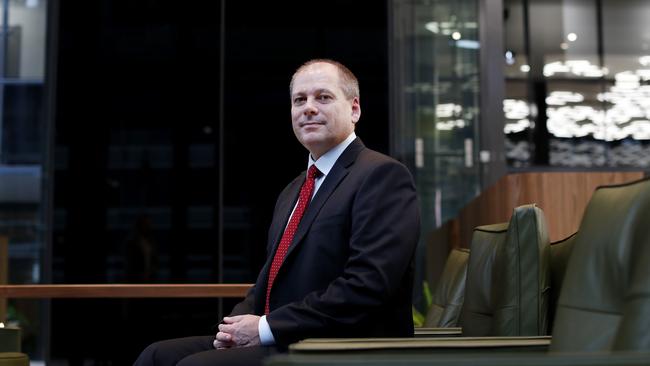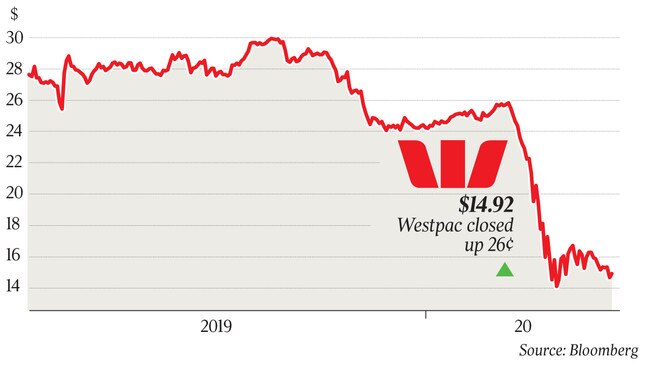Westpac sets aside $2.2bn provision for losses, eases capital raising fears
Westpac expects COVID-19 loan losses could hit $1.6bn, but sources say the bank will avoid raising fresh capital.

Westpac expects that COVID-19 loan losses could hit $1.6bn during the nation’s first deep recession in almost 30 years, but sources say the bank’s preference is to sidestep raising fresh capital.
Westpac on Tuesday revealed it had revised expectations for how the economy would fare through the crisis, ascribing a “higher probability” to an even worse scenario across metrics such as unemployment, and residential and commercial property prices.
With estimates that ANZ faces as much as $1.2bn in COVID-19 related impairment charges when it delivers results on Thursday, this could push lending losses closer to $4bn for the three major banks that operate with an end-March cycle.
Westpac is taking a first-half impairment charge of $2.24bn pre-tax, with about $1.6bn of the new charges “predominantly related” to the COVID-19 impact. It also noted an additional $600m in individually assessed provisions and net write-offs as it delved into specific loan book exposures. The $1.6bn tally is about double the $807m COVID-19 charge National Australia Bank outlined at its profit results on Monday, to launch a $3.5bn capital raising and slash its dividend to 30c per share.
The big banks are seeking to traverse the coronavirus turmoil which has spurred massive disruption and shutdowns across the economy, prompting fears of a surge in unemployment and loan losses.
They are balancing that with a directive from the banking regulator that they should give serious consideration to suspending dividends or markedly reduce the payments to conserve capital.
Sources told The Australian Westpac preferred not to tap investors for fresh funds, particularly for a second time within six months and as bank stocks trade below book value, or the value of total assets less liabilities.

The boards of ANZ and Westpac are also in the final throes of dividend deliberations for first-half distributions to investors.
Sources said ANZ, which delivers interim profits on Thursday, was leaning toward deferring its first-half payment, although that position may be revised after NAB announced a markedly reduced dividend rather than a suspension.
On expected loan losses, UBS last week estimated that ANZ would provide an additional provision of $1.25bn related to the pandemic’s fallout.
Commonwealth Bank, which rules off its accounts at the end of June, is not scheduled to deliver its results until later this year.
In Tuesday’s statement new Westpac chief executive Peter King highlighted the challenges posed by COVID-19, but said the bank was “well positioned” to absorb higher loan losses. He is preparing to hand down first-half profits on Monday.
“The world is going through a once in a lifetime health and economic crisis and we are committed to assisting as many customers as possible to bridge this shutdown period,” he said.
“It is, however, unfortunate that some customers will not be able to navigate the financial and economic changes of this crisis and may not reopen. Nevertheless, we will work closely with those customers to help them through that process.”
Westpac expects economic activity will slide 8.5 per cent in the June quarter and 5 per cent for 2020, after output improves in the December quarter.
NAB chief executive Ross McEwan on Monday said the bank considered a range of dividend scenarios from zero payment to 40c per share, eventually landing on 30c and a capital raising to shore up its balance sheet.
“We thought this was the right balance … we looked with various scenarios,” he added.
Westpac’s shares rallied 1.8 per cent to $14.92 on Tuesday as the bank’s capital buffers printed ahead of expectations. The stock had declined 4.4 per cent on Monday.
The bank’s first-half credit impairment charge of $2.24bn equates to about 62 basis points of gross loans, annualised. That compares to 13 basis points and 9 basis points for the two prior halves respectively.
The bank said the $1.6bn addition to the impairment charge had “a relatively small impact” on its common equity tier-one capital ratio with an 11-basis point decrease expected.
“This is because the higher charge lifts provision levels and reduces the regulatory expected loss capital deduction to nil. Westpac’s CET1 capital ratio at 31 March 2020 is expected to be 10.8 per cent.”
That is above the Australian Prudential Regulation Authority’s “unquestionably strong” threshold.
“Westpac took a more cautious approach toward providing for COVID-19 impacts in the provisioning charge, whereas NAB’s conservatism was evident in the pre-emptive capital raise,” fund manager Martin Currie’s senior analyst Matthew Davison said.
“Westpac’s first-half 2020 charge annualises at 62 basis points of gross loans, which is higher than consensus full-year expectations. However, it remains to be seen how the charge will evolve and will depend on how much weight the bank has placed on different scenarios and the duration of impacts.
“The sensitivity of Westpac’s credit risk-weighted assets to COVID-19 scenarios will be a key area to watch going forward.”
Bell Potter analyst TS Lim said the tone of Westpac’s statement suggested there was “no need” for it to raise additional capital.
The bank tapped investors for $2.77bn in November, just ahead of financial crimes regulator Austrac launching legal action against it.
Westpac earlier this month outlined $1.43bn in writedowns and charges to interim profit, as it put aside $900m for the expected financial crimes penalty and cautioned of further customer compensation costs.
“While impairment provisions have begun to increase, the extent of additional charges in subsequent periods will depend on the severity and duration of the decline in economic activity and the size and effectiveness of stimulus,” it said.






To join the conversation, please log in. Don't have an account? Register
Join the conversation, you are commenting as Logout